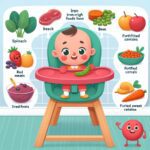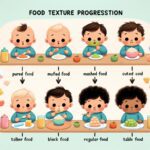Understanding the best practices for transitioning from purees to solid food is a milestone that many parents look forward to with anticipation and, sometimes, a bit of anxiety. This transition is not just about introducing new textures and flavors to your baby’s diet; it’s about setting the foundation for healthy eating habits that will last a lifetime.
Recognizing the Signs of Readiness
Before diving into the world of solid foods, it’s crucial to identify the signs that your baby is ready for this next step. These signs usually emerge around the 6-month mark but can vary for each child. Look for cues such as improved head control, the ability to sit up with minimal support, and an increased interest in the foods you’re eating. A decreased tongue-thrust reflex, which pushes food out of the mouth, is another key indicator. For more detailed insights on readiness signs, consider reading about signs that your baby is ready for solid foods earlier than expected.
Moving on from purees to more textured foods is a significant step for your baby. The right approach can make this transition smoother and more enjoyable for both of you.
Best Practices for Transitioning from Purees to Solid Food
Once you’ve determined your baby is ready, the journey from purees to solid food begins. Here are some best practices to guide you:
Start with soft, easily mashable foods. Think cooked vegetables, ripe fruits, and tender meats. These can be cut into small, bite-sized pieces to encourage self-feeding. Introducing a variety of textures and flavors early on can help prevent pickiness later.
Encourage exploration and be patient. Your baby might not take to new textures immediately, and that’s okay. Each child’s journey is unique. Offering a variety of foods and textures, even if they initially reject them, is crucial. For more tips on dealing with texture introduction, check out our guide on introducing texture in baby food.
Keep meal times stress-free and positive. Sit with your baby and eat together, making mealtime a social and enjoyable experience. This not only helps your baby learn by watching you but also reinforces the importance of family meals.
Stay mindful of potential choking hazards and always supervise your baby during meals. Cut foods into appropriate sizes, and avoid hard, round, and slippery foods unless they are properly prepared to be safe for your baby.
Remember, the transition to solid foods is a gradual process. It’s important to continue breastfeeding or formula feeding alongside solid food introduction. This ensures your baby receives all the necessary nutrients during this transition period. For balancing solid food and milk intake, consider reading about balancing solid food and milk intake for 9-month-olds.
Common Challenges and Solutions
Transitioning from purees to solid food is not without its challenges. From dealing with picky eaters to managing gagging and ensuring nutritional adequacy, parents often encounter a few bumps along the way.
For picky eaters, the key is persistence and creativity. Offer new foods multiple times in a non-pressuring way, and try presenting them alongside familiar favorites. Engaging your child in the food preparation process can also spark their interest in trying new things. For strategies tailored to young children, explore how to handle dealing with picky eaters.
Gagging is a natural part of learning to eat more textured foods, but it can be alarming. Ensure you know the difference between gagging and choking and how to respond to each situation. Always supervise your baby closely during meals to intervene if necessary.
Nutritional adequacy is crucial during this transition. While exploring solid foods, it’s vital to ensure your baby receives a balanced diet rich in essential nutrients. Incorporating iron-rich foods is particularly important as infants’ iron stores begin to deplete around 6 months. For guidance on iron-rich foods suitable for babies starting on solids, refer to our article on top iron-rich foods for babies starting on solids.
In conclusion, transitioning your baby from purees to solid food is a journey filled with exciting milestones and, sometimes, a few challenges. By following best practices, staying patient, and being responsive to your child’s cues, you can ensure a positive experience that lays the groundwork for healthy eating habits. Remember, every baby is unique, and the transition will happen at its own pace. Embrace this special time with your little one and enjoy the adventure of introducing them to the wonderful world of solid foods.













